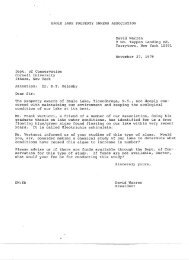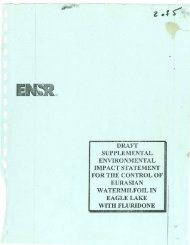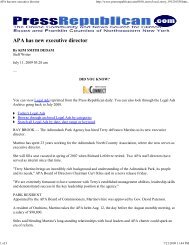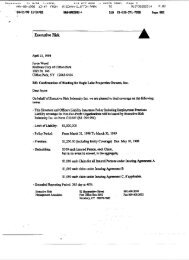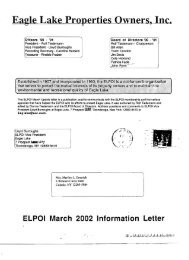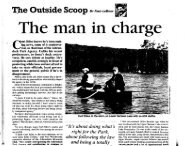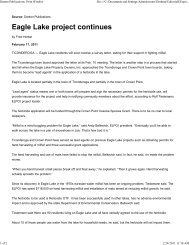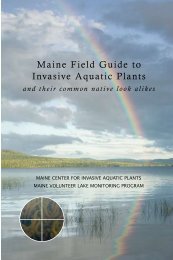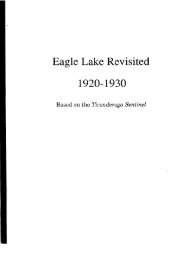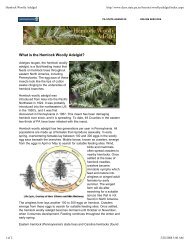Adirondack Park - Eagle Lake Property Owner's Inc.
Adirondack Park - Eagle Lake Property Owner's Inc.
Adirondack Park - Eagle Lake Property Owner's Inc.
Create successful ePaper yourself
Turn your PDF publications into a flip-book with our unique Google optimized e-Paper software.
Board. Member counties contribute staff and other resources to the program on an in-kind basis.<br />
In many counties, FL-LOWPA funds have leveraged additional moneys through grants and local<br />
appropriations.<br />
Coalition of <strong>Lake</strong>s Against Milfoil (COLAM)<br />
The Coalition of <strong>Lake</strong>s Against Milfoil was formed in 1991, and is a statewide organization<br />
comprised of lake association representatives, property owners, businesses and concerned<br />
individuals. COLAM is an advocacy group for the interests of people concerned about New<br />
York State's handling of the threat posed by Eurasian watermilfoil and other aquatic nuisance<br />
species. COLAM has called on New York State to streamline the permitting process to allow for<br />
rapid and effective response when invasive aquatic plant species are detected in a water body.<br />
The group would also like the State to act as partners with lake associations by providing funding<br />
and technical assistance with weed management projects.<br />
Regional<br />
<strong>Lake</strong> Champlain Basin Program<br />
The <strong>Lake</strong> Champlain Basin Program (LCBP) was established to coordinate the activities<br />
envisioned by the <strong>Lake</strong> Champlain Special Designation Act of 1990. It is jointly administered by<br />
the U.S. Environmental Protection Agency, the states of Vermont and New York and the New<br />
England Interstate Water Pollution Control Commission. Other cooperating agencies include the<br />
U.S. Fish and Wildlife Service, the U.S. Department of Agriculture, the U.S. Geological Survey,<br />
the National Oceanographic and Atmospheric Administration, the U.S. Army Corps of<br />
Engineers, and the National <strong>Park</strong> Service. Formal involvement of Quebec is through the <strong>Lake</strong><br />
Champlain Basin Program’s Steering Committee. The LCBP coordinated the development of<br />
Opportunities For Action: An Evolving Plan for the Future of the <strong>Lake</strong> Champlain Basin (OFA),<br />
which was first published in 1996 and revised in 2003. One of the top four priority issues in OFA<br />
is nonnative aquatic nuisance species. The LCBP conducts education and outreach activities for<br />
ANS throughout the Basin, facilitates discussion among ANS resource managers and has<br />
administered more than $1.3 million in grants for ANS research, monitoring, education, control<br />
and demonstration programs. About 20 percent of the <strong>Adirondack</strong> <strong>Park</strong> is contained within the<br />
<strong>Lake</strong> Champlain Basin. The LCBP has ex-officio representation on the national ANS Task<br />
Force and receives support through the Task Force for an ANS Coordinator.<br />
Northeast Aquatic Nuisance Species Panel<br />
The Northeast Aquatic Nuisance Species (NEANS) Panel was established in 2001, and is the<br />
fourth regional panel to be established under the auspices of the Federal Aquatic Nuisance<br />
Species Task Force (ANSTF), following the Great <strong>Lake</strong>s, Western Regional, and Gulf of Mexico<br />
panels. The mission of the NEANS Panel is to "protect the marine and freshwater resources of<br />
the Northeast from invasive aquatic nuisance species through commitment and cohesive<br />
coordinated action".<br />
36



